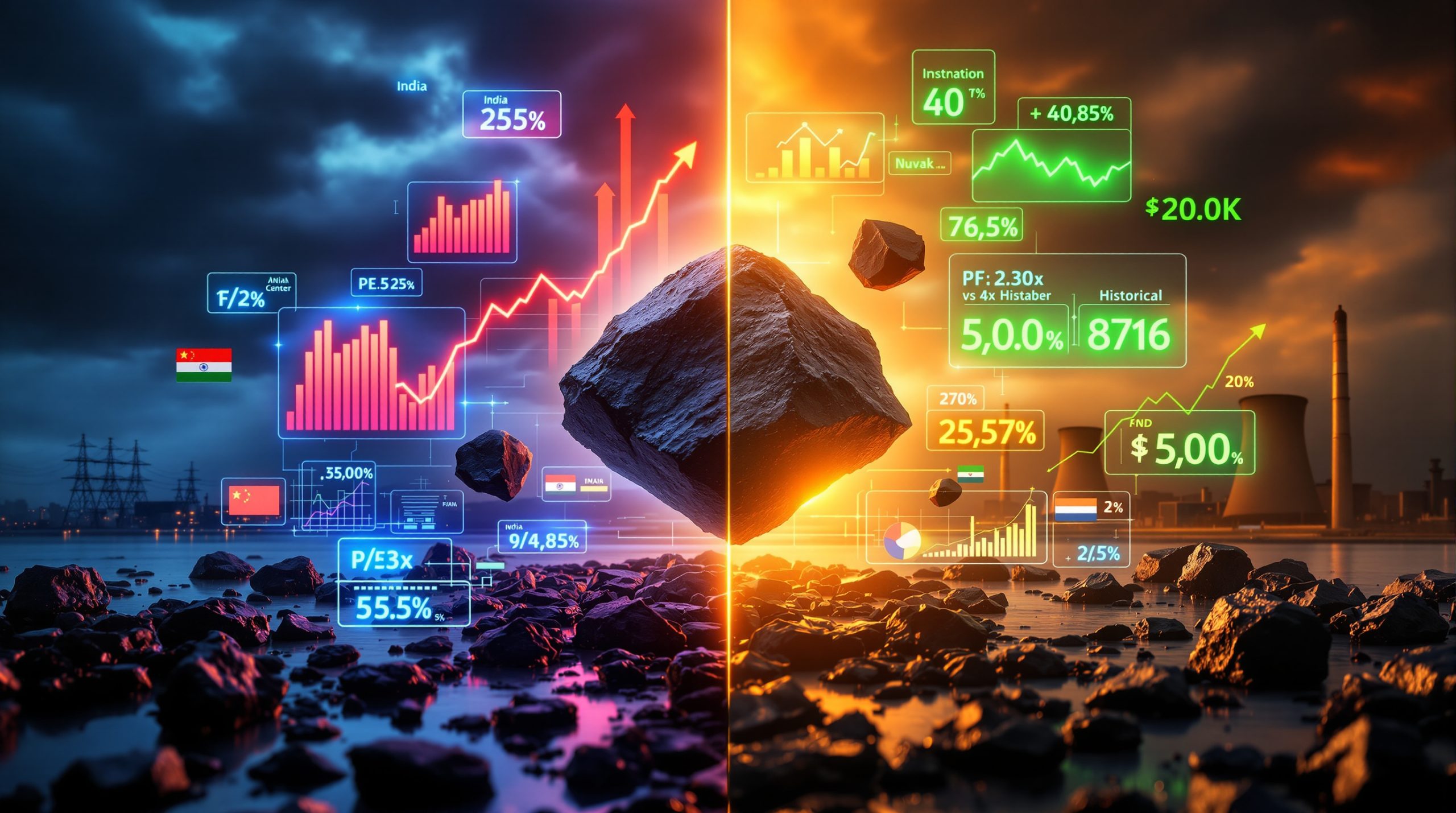Understanding Gold's Journey to Record Territory
The precious metals market has witnessed extraordinary volatility as gold price above $4,000 becomes the new battleground for traders and investors worldwide. Following a dramatic surge exceeding 50% throughout 2025, gold has established itself firmly in uncharted territory, fundamentally altering market dynamics and investment strategies across the sector. Furthermore, gold prices analysis reveals the complex factors driving this unprecedented rally.
Recent trading sessions have demonstrated the metal's resilience, with December futures recovering to $4,021 per ounce after experiencing significant intraday pressure. This recovery pattern highlights the underlying strength supporting elevated price levels, even as profit-taking activities create temporary downward pressure on valuations.
The market capitalisation implications extend far beyond gold itself, influencing the broader precious metals complex and related mining equities. Silver, platinum, and palladium have all experienced heightened volatility as investors recalibrate their exposure to alternative monetary assets during this unprecedented price environment.
Technical Analysis of the $4,000 Threshold
From a technical perspective, the $4,000 level has emerged as a critical psychological and structural support zone. Trading volume patterns during breakthrough attempts reveal institutional positioning strategies, with elevated volumes typically accompanying downward moves as leveraged positions unwind rapidly.
Professional dealers observe that crowded long positions create vulnerability during momentum shifts, particularly when leveraged traders move to secure profits simultaneously. This dynamic explains the sharp intraday movements that have characterised recent trading sessions around the $4,000 threshold.
Futures market positioning indicates continued institutional interest despite short-term volatility. The concentration of open interest around key strike prices suggests that options activity remains robust, providing both support and resistance levels that influence daily price action.
Which Economic Factors Enable Gold's $4,000+ Valuations?
Monetary Policy Drivers
Central bank monetary policy continues serving as the primary catalyst supporting gold price above $4,000 levels. The Federal Reserve's anticipated 25 basis point rate reduction represents the second consecutive easing move, maintaining accommodative conditions that reduce the opportunity cost of holding non-yielding assets.
Global central bank gold accumulation patterns have evolved significantly, with purchasing activity moderating from previous peaks while maintaining steady underlying demand. This shift reflects strategic reserve diversification efforts rather than panic-driven acquisition, suggesting more sustainable long-term support for elevated price levels.
Currency debasement concerns across major economies provide additional structural support. The debasement trade phenomenon has attracted retail investors seeking protection from expanding budget deficits and potential sovereign debt challenges, creating a broader investment base beyond traditional institutional participants. However, understanding gold as inflation hedge becomes crucial for investors navigating this complex environment.
Key monetary policy factors supporting elevated gold prices include:
• Real interest rates remaining below historical averages despite recent policy adjustments
• Quantitative easing programmes continuing across multiple jurisdictions
• Debt-to-GDP ratios reaching concerning levels in developed economies
• Central bank balance sheet expansion creating long-term currency dilution risks
Inflation and Real Interest Rate Dynamics
The relationship between real yields and gold valuations remains inverse and pronounced at current price levels. Consumer price index impacts demonstrate how inflationary pressures, even when moderating, continue supporting precious metals demand when adjusted for nominal interest rates.
Historical precedents during major inflationary periods provide context for current valuations. The 1970s stagflation era witnessed gold appreciation exceeding 2,000% over the decade, while more recent episodes following the 2008 financial crisis saw 168% gains between 2007 and 2011.
Real yield calculations currently indicate negative returns on government bonds when adjusted for inflation expectations, maintaining the attractiveness of alternative stores of value. This dynamic becomes particularly pronounced when considering longer-term investment horizons and potential policy normalisation timelines.
| Economic Event | Time Period | Gold Price Change | Key Driver |
|---|---|---|---|
| 2008 Financial Crisis | 2007-2011 | +168% | Safe haven demand |
| COVID-19 Pandemic | 2020-2021 | +24% | Stimulus measures |
| Current Cycle | 2024-2025 | +50%+ | Multiple factors |
How Do Geopolitical Tensions Impact Gold Above $4,000?
Regional Conflict Effects on Precious Metals
Geopolitical developments continue shaping gold price above $4,000 dynamics through multiple transmission channels. US-China trade negotiations create immediate volatility, with progress announcements typically pressuring safe haven demand while setbacks provide support for precious metals positioning.
Military tensions across various global regions contribute to sustained elevated demand for politically neutral assets. Unlike traditional safe havens that remain subject to specific sovereign risks, gold maintains its attraction as a universal store of value during periods of international uncertainty.
Diplomatic relationship deterioration between major economic powers creates currency instability that supports alternative monetary assets. Trade war implications extend beyond immediate tariff impacts, affecting long-term confidence in fiat currency systems and international payment mechanisms. Moreover, experts are predicting significant price increases as these tensions continue to escalate.
The interconnected nature of modern geopolitical risks creates compound effects on precious metals markets:
• Supply chain disruptions affecting global commerce and commodity flows
• Energy security concerns influencing economic stability and growth prospects
• Financial system fragmentation reducing confidence in traditional monetary arrangements
• Resource nationalism impacting mining operations and metal availability
Supply Chain Security Considerations
Mining operation disruptions in key producing regions create supply-side constraints that support elevated gold prices. Environmental regulations, permitting delays, and infrastructure limitations combine to restrict new production capacity, particularly as ore grades continue declining across major mining districts.
Transportation and logistics challenges affect physical gold markets differently than paper markets, creating periodic disconnects between spot prices and delivery premiums. Strategic reserve policies implemented by various nation-states further reduce available supply for commercial markets.
The concentration of gold production in politically sensitive regions adds geopolitical risk premiums to long-term price projections. Major producing countries including Russia, China, and several African nations face varying degrees of international sanctions or political instability that could affect future supply availability.
What Role Does Investment Demand Play at These Price Levels?
Exchange-Traded Fund Accumulation Patterns
Physically-backed ETF holdings approach 2020 peak levels, indicating sustained institutional and retail interest despite elevated prices. Digital platform participation has democratised precious metals investment, allowing smaller investors to access gold exposure without traditional storage and insurance costs.
Professional portfolio managers implement strategic allocation adjustments that support demand even at higher price levels. The diversification benefits become more pronounced during periods of equity market volatility and bond market uncertainty, encouraging maintained or increased exposure percentages.
Retail investor participation through fractional ownership platforms has expanded the accessible market significantly. This democratisation effect creates more stable demand patterns compared to traditional institutional-dominated markets, as smaller investors typically exhibit less price sensitivity and longer investment horizons.
Portfolio Diversification Strategies
Alternative asset allocation strategies increasingly recognise gold's role in risk-adjusted portfolio construction. Hedge fund positioning reveals sophisticated approaches to precious metals exposure, including derivatives strategies and paired trades that capitalise on relative value opportunities.
Pension fund and sovereign wealth fund activities demonstrate long-term institutional confidence in gold price above $4,000 sustainability. These large-scale investors typically conduct extensive due diligence before establishing positions, suggesting fundamental support for current valuation levels. Additionally, understanding the gold-stock relationship helps investors optimise their portfolio allocation strategies.
Key Insight: Professional dealers suggest that while central bank demand has moderated from previous peaks, the diversification trade continues supporting elevated price levels.
Modern portfolio theory applications increasingly incorporate gold as a permanent allocation rather than tactical positioning. This shift toward strategic rather than opportunistic exposure creates more stable demand patterns that support sustained higher prices.
Can Gold Sustain Prices Above $4,000 Long-Term?
Supply-Side Constraints Analysis
Global mine production capacity faces structural limitations that support long-term gold price above $4,000 levels. Exploration and development timelines extend over decades, creating supply inelasticity that prevents rapid production increases in response to higher prices.
Environmental and regulatory hurdles for new mining projects have intensified significantly, particularly in developed countries with established environmental protection frameworks. Permitting processes now require comprehensive environmental impact assessments, community consultation programmes, and long-term remediation planning.
The declining average ore grade across existing mining operations creates cost pressures that support higher floor prices. Many established mines now process ore containing less than 2 grams per ton of gold, compared to historical averages exceeding 5 grams per ton in major deposits discovered decades ago.
Critical supply-side factors include:
• Capital expenditure requirements for new mine development exceeding historical levels
• Infrastructure limitations in remote mining regions requiring significant investment
• Water availability concerns affecting processing operations in arid regions
• Energy costs representing increasing percentages of total production expenses
Demand Sustainability Factors
Technology sector gold consumption continues expanding despite higher prices, driven by increasing electronic device production and emerging applications in renewable energy systems. Industrial demand demonstrates relative price insensitivity due to gold's unique physical properties and small material costs relative to finished product values.
Jewellery market adaptation to higher prices involves design modifications and alternative materials, but cultural significance in major consuming regions maintains underlying demand. Countries including India and China demonstrate continued ceremonial and investment purchasing despite elevated price levels.
Investment demand sustainability depends on maintaining economic conditions that favour alternative monetary assets over traditional financial instruments. This includes continued expansive monetary policies, elevated government debt levels, and periodic financial market instability. Furthermore, gold market performance indicates sustained investor confidence despite volatility.
| Demand Category | Percentage Share | Price Sensitivity | Outlook |
|---|---|---|---|
| Investment | 45% | Low | Stable |
| Jewellery | 35% | High | Declining |
| Technology | 12% | Medium | Growing |
| Central Banks | 8% | Low | Stable |
What Are the Risks to Gold Prices Above $4,000?
Market Correction Scenarios
Leveraged position unwinding presents the most immediate risk to gold price above $4,000 sustainability. Professional analysts observe that crowded long positions become vulnerable when momentum shifts, particularly as overleveraged traders rush to secure profits or meet margin requirements.
Technical resistance levels around $4,380 established during recent peak trading create psychological selling pressure during approach attempts. Momentum shifts can trigger algorithmic selling programmes that exacerbate downward price movements, potentially creating self-reinforcing correction cycles.
Correlation breakdowns with traditional safe haven patterns could reduce gold's attractiveness during crisis periods. If economic uncertainty fails to translate into precious metals demand due to changing investor preferences or alternative asset availability, fundamental support could weaken significantly.
Economic Recovery Impact Factors
Dollar strength potential during robust economic growth phases creates headwinds for gold prices denominated in the reserve currency. Interest rate normalisation effects become pronounced when real yields turn decisively positive, increasing the opportunity cost of holding non-yielding assets.
Alternative investment attractiveness could redirect capital flows away from precious metals. Strong equity market performance, attractive real estate yields, or innovative financial products might capture investment flows currently supporting elevated gold demand.
Economic recovery scenarios that reduce systemic risks and restore confidence in traditional financial systems could undermine the fundamental drivers supporting gold price above $4,000. Successful debt reduction programmes, monetary policy normalisation, and restored international cooperation might reduce safe haven demand significantly.
Regulatory and Policy Considerations
Potential government intervention in precious metals markets represents a tail risk that could dramatically affect prices. Historical precedents include gold ownership restrictions, transaction taxes, and mandatory reporting requirements that could discourage investment demand.
Tax policy changes affecting precious metals investment vehicles might alter demand patterns substantially. Capital gains tax modifications, ETF treatment adjustments, or retirement account restrictions could redirect investment flows toward other asset classes.
International monetary system reforms could reduce gold's role as an alternative reserve asset. Central bank digital currencies, reformed international payment systems, or new monetary arrangements might diminish demand from both official and private sector participants.
How Should Investors Approach Gold Above $4,000?
Position Sizing and Risk Management
Portfolio allocation recommendations for gold price above $4,000 require careful consideration of individual risk profiles and investment objectives. Conservative investors might maintain 5-10% allocations to precious metals, while more aggressive strategies could justify 15-20% exposure during periods of heightened economic uncertainty.
Dollar-cost averaging strategies become particularly relevant during volatile periods, allowing investors to build positions gradually without attempting to time specific entry points. This approach helps mitigate the impact of short-term price fluctuations while maintaining long-term exposure to potential upside movements.
Stop-loss and profit-taking methodologies require adaptation to higher absolute price levels and increased volatility. Traditional percentage-based approaches might need adjustment to account for the larger dollar amounts involved and the unique characteristics of precious metals markets.
Risk management considerations include:
• Storage and insurance costs for physical holdings increasing with higher values
• Counterparty risks associated with ETFs and mining company investments
• Liquidity considerations during stressed market conditions
• Tax implications varying significantly across investment vehicles and jurisdictions
Investment Vehicle Comparison
Physical gold versus ETF considerations become more complex at elevated price levels. Direct ownership provides maximum security and control but involves storage costs, insurance requirements, and potential liquidity constraints during rapid market movements.
Mining stock leverage and correlation factors offer amplified exposure to gold price movements but introduce company-specific risks including operational challenges, financial leverage, and management decisions. Major gold producers typically provide 2-3x leverage to underlying metal prices during favourable market conditions.
Derivatives and options strategies enable sophisticated investors to implement targeted exposure strategies, including protective puts, covered calls, and spread trades. These instruments require advanced understanding but offer flexibility in managing risk and enhancing returns during volatile markets.
Timing and Market Entry Strategies
Technical indicator analysis suggests multiple entry point opportunities during normal market volatility cycles. Moving average crossovers, relative strength measurements, and momentum indicators provide guidance for tactical positioning decisions within longer-term strategic allocations.
Fundamental catalyst identification helps investors anticipate major price movements based on economic developments, policy announcements, and geopolitical events. Understanding the relationship between various catalysts and gold price responses improves timing decisions significantly.
Long-term versus short-term positioning approaches require different analytical frameworks and risk tolerance levels. Strategic investors focus on multi-year trends and structural economic factors, while tactical traders emphasise technical patterns and short-term market inefficiencies.
What Do Analysts Predict for Gold Beyond $4,000?
Price Target Analysis
Investment bank forecasts demonstrate significant variation in gold price above $4,000 projections, reflecting different assumptions about economic growth, monetary policy, and geopolitical developments. Conservative estimates suggest $4,200-$4,400 potential targets based on current momentum and fundamental support levels.
Scenario-based modelling incorporates multiple economic outcomes, from continued monetary accommodation to aggressive policy normalisation. Optimistic scenarios project potential advances toward $4,600-$4,800, while pessimistic outcomes suggest possible corrections to $3,600-$3,800 ranges.
Historical pattern recognition and cycle analysis provide additional perspective on potential price trajectories. Previous major gold bull markets have typically lasted 8-12 years, suggesting the current cycle might have additional upside potential despite already substantial gains. In fact, recent analysis shows analysts predicting gold could top $4,000 annually for the first time.
Timeline Expectations
Short-term volatility predictions emphasise the potential for 10-15% price swings within 3-6 month periods as markets adjust to changing economic conditions and investor sentiment. Professional traders prepare for continued elevated volatility around the $4,000 threshold.
Medium-term structural support levels appear established between $3,800-$4,200 over 1-2 year timeframes, assuming continued accommodative monetary policies and elevated geopolitical tensions. These levels reflect fundamental demand from diversification trades and central bank activities.
Long-term secular trend implications extend over 5+ year periods, with ultimate price potential depending on resolution of current monetary system challenges and international economic arrangements. Successful policy normalisation could limit upside, while continued expansion could support significantly higher levels. Consequently, gold price forecast models suggest continued upward momentum through various economic scenarios.
Market Perspective: Some analysts project potential targets of $4,200-$4,400 based on current momentum, while others caution about near-term corrections to $3,800 levels.
Conclusion: Navigating Gold's New Price Reality
Key Takeaways for Market Participants
The establishment of gold price above $4,000 as a sustainable trading range represents a fundamental shift in precious metals markets. Primary drivers including monetary policy accommodation, geopolitical uncertainty, and currency debasement concerns provide structural support that extends beyond traditional cyclical factors.
Risk-reward assessments at current valuations require sophisticated analysis incorporating both traditional fundamental factors and evolving market dynamics. While elevated prices create profit-taking pressures and potential correction risks, underlying economic conditions continue supporting alternative monetary asset demand.
Strategic considerations vary significantly across investor types, from conservative portfolio diversification to aggressive precious metals concentration strategies. Success in the current environment requires understanding both technical trading dynamics and fundamental economic trends affecting long-term price sustainability.
Monitoring Framework for Future Developments
Economic indicators deserving continuous monitoring include real interest rate trends, central bank policy communications, and currency stability measures across major economies. Changes in these fundamental drivers could signal significant shifts in gold price direction and sustainability.
Geopolitical events with highest market impact potential include trade negotiations between major powers, military conflicts affecting global stability, and international monetary system reforms. These developments often create immediate volatility while establishing longer-term trend directions.
Technical levels requiring attention include the $4,000 support zone, $4,380 resistance area, and various intermediate levels that could signal trend reversals or continuation patterns. Volume analysis and institutional positioning data provide additional insights into potential price direction changes.
Key monitoring points include:
• Federal Reserve policy meeting outcomes and forward guidance communications
• Central bank gold purchase announcements from major reserve managers
• Geopolitical tension escalation or resolution affecting safe haven demand
• Economic data releases indicating inflation trends and growth prospects
• Technical chart patterns signalling potential trend changes or continuations
Disclaimer: This analysis is for educational and informational purposes only. Precious metals investments carry significant risks, including price volatility and potential losses. Market predictions involve substantial uncertainty, and past performance does not guarantee future results. Readers should conduct independent research and consult qualified financial advisors before making investment decisions. Economic forecasts and analyst projections represent opinions that may prove incorrect, and geopolitical developments can create unpredictable market impacts.
Ready to Capitalise on Major Gold Mining Discoveries?
Discovery Alert's proprietary Discovery IQ model delivers real-time notifications on significant ASX mineral discoveries, empowering subscribers to identify actionable opportunities ahead of the broader market during periods of extraordinary gold price volatility. With gold surging above $4,000 and mining companies potentially benefiting from these unprecedented levels, explore Discovery Alert's discoveries page to understand how historic mineral discoveries have generated substantial returns, then begin your 30-day free trial to position yourself ahead of the market.




